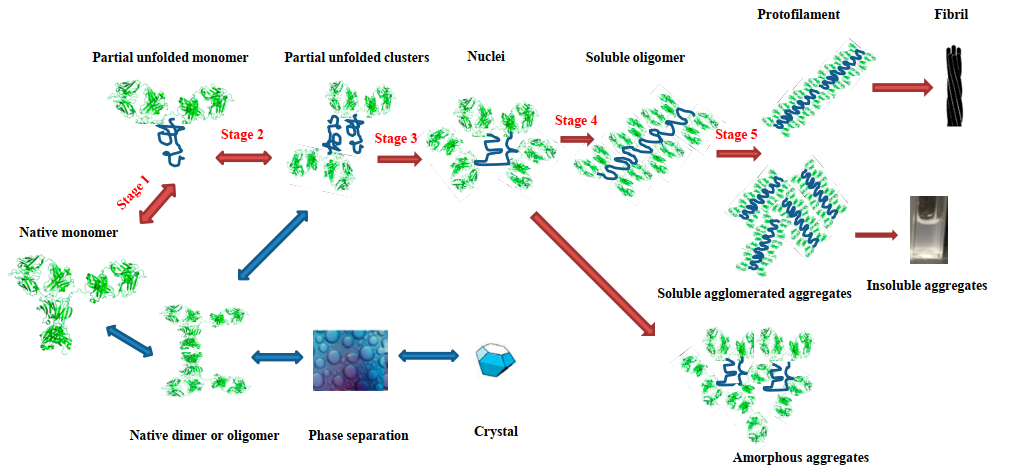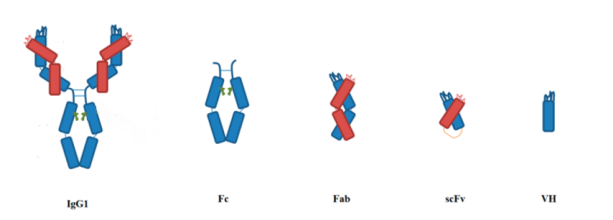Stability Design & Aggregation in Antibody
Protein aggregation remains a major area of focus in the production of monoclonal antibodies (mAbs). Improving the intrinsic properties of antibodies can improve manufacturability, attrition rates, safety, formulation, titers, immunogenicity, and solubility. As a leading provider of superior custom antibody development services, Creative Biolabs offers a wide range of industry-leading antibody design platforms and services to increase antibody stability and reduce antibody aggregation. We can customize a discovery and development path to fit your exact needs.
How Do Protein Aggregate?
Protein aggregation is a complex process with no established single mechanism. Several states of proteins (folded, partially unfolded, unfolded) may participate in the aggregation of monomers into small multimers and then into larger oligomeric structures in a reversible or irreversible manner. Generally, the aggregation process mediated by folding intermediates can be divided into the following five stages (Fig.1):
 Fig. 1 Schematic representation of the protein aggregation process and the possible involved intermediates.1
Fig. 1 Schematic representation of the protein aggregation process and the possible involved intermediates.1
1) Partial unfolding of the native monomer;
2) Reversible self-association of the partially-unfolded or folded protein;
3) Net irreversible aggregation nuclei formation;
4) Further aggregation growth by monomer chain addition;
5) Aggregation association to form the high molecular weight soluble aggregates or insoluble precipitation.
Our Strategies to Reduce Protein Aggregation
- The Design Based on Sequence and Structure
Although protein aggregation is a priori unpredictable kinetically, the thermodynamic aggregation potentials can be inferred from the intrinsic characteristics of protein/antibody sequences and structural features. Therefore, aggregation can be well controlled by the rational design of protein/antibody sequences and structures. Protein unfolding and the nucleation are critical steps for protein aggregation, with subsequent monomer addition and aggregate association occurring much faster. Thus, strategies ameliorating aggregation often target the aggregation Stages I, II and III. The corresponding methods to mitigate aggregation are:
✔ Stabilizing the native monomer or destabilizing the partially-unfolded monomer to reduce the likelihood of protein unfolding at Stage I;
✔ Altering the surface charge distributions to increase the electronic repulsion between the unfolded monomers at Stage II;
✔ Disturbing the structural re-arrangements of unfolded monomers in Stage III to disfavor hydrophobic contacts and the packing of β strands.
- Computational Design for Predicting Protein Aggregation:
The propensity to aggregate is often identified too late in the development phase to modify the antibody sequence. Therefore, it is important to predict and combine rational design to improve antibody stability in early discovery. Studies have shown that certain sequence or structural features, known as aggregation-prone regions (APRs), can drive protein aggregation. Recently, many computational methods have been developed to predict APRs in mAbs and to rationalize antibody sequences. At Creative Biolabs, we have proprietary software platforms to predict APRs in mAbs and to rationalize antibody sequences. These platforms include:
✔ PAGE (Prediction of Aggregation)
✔ TANGO (a statistical mechanics algorithm)
✔ Spatial aggregation propensity (SAP)
- Other Optimized Strategies
In addition to the above design, Creative Biolabs offers other optimized strategies to improve antibody stability, including:
✔ Single point mutations of APRs
✔ Engineering glycosylation sites near APRs to mask these residues with carbohydrate moieties
Both of these methods result in comparable decreases in aggregation and an up to a 4-fold reduction in monomer loss. These single mutations and new glycosylation patterns of the Fab domain do not alter binding to the target. Thus, antibodies with increased stability against aggregation can be produced in a rational manner by removing or masking APRs or crowding out protein-protein interactions.
Our Advantages of Antibodies Design
- Display a significantly decrease in aggregation propensity while retaining antigen binding;
- The reduction in aggregation propensity is accompanied by an increase in expression titer, which is beneficial throughout the development process;
- Our design can significantly reduce liabilities in novel therapeutic antibodies and proteins, providing a more efficient path to clinical studies;
- Our strategies are applicable to all types of antibody molecules, including but not limited to the following:
 Fig. 2 Molecular architecture of an immunoglobulin G1 (IgG1) antibody and its fragments. (W Li; et al., 2016)
Fig. 2 Molecular architecture of an immunoglobulin G1 (IgG1) antibody and its fragments. (W Li; et al., 2016)
Customer Support
- Rational programs with practiced expert teams
- Regular progress updates
- Written reports available at the end of each phase
- A full of delivery with detailed interpretations
Reasonable antibody design can help you effectively reduce the total cost of antibody R&D and shorten the R&D cycle. If you have a need for this, please contact us for the quotation form. We will process your order immediately.
Reference
- Li, W.; et al. Antibody aggregation: insights from sequence and structure. Antibodies. 2016, 5(3): 19. Distributed under Open Access license CC BY 4.0, without modification.
For Research Use Only.
